Fertilizer Placement and Timing
This module is the eleventh in a series of Extension materials designed to provide Extension agents, Certified Crop Advisers (CCAs), consultants, and producers with pertinent information on nutrient management issues. To make the learning “active,” and to provide credits to CCAs, a quiz accompanies this module. In addition, realizing that there are many other good information sources including previously developed Extension materials, books, web sites, and professionals in the field, we have provided a list of additional resources and contacts for those wanting more in-depth information. This module covers Rocky Mountain CCA Nutrient Management Competency Area VI: Nutrient Source and Applications, with the focus on fertilizer placement and timing.
Last Updated: 05/09by Clain Jones, Extension Soil Fertility Specialist; and Jeff Jacobsen, College of Agriculture Dean
Objectives
After completing this module, the reader should:
- Be able to identify fertilizer placement options.
- Know the various fertilizer timing options.
- Understand the effects of fertilizer placement and timing on crop yield and quality.
- Be familiar with the effects of fertilizer placement and timing on emergence, fertilizer use efficiency, weeds, and water quality.
Background
The effective placement and timing of fertilizers can maximize both yield and nutrient use efficiency, thereby increasing net profit for the producer. With advances in technology, placement and timing options have increased in the past few decades. In addition, a large amount of research has been conducted in the past 25 years on the effects of various placement and timing methods on crop yield, quality, emergence, fertilizer use efficiency, weeds, and water quality.
Fertilizer Placement and Timing Methods
There are a variety of terms used to describe both placement and timing (Table 1). Selected methods are described in more detail below.
Granular fertilizer can be broadcast (surface applied), broadcast-incorporated (“plowdown”), surface banded, or deep banded. Liquid fertilizer can be broadcast, banded with either a point (“spoke”) injector, shank, or dribble applicator, or applied to the growing plants (foliar application or fertigation). Banding can be performed prior to seeding, with/near the seed (“starter” or “pop-up”), or after planting.
Equipment needed to broadcast is generally less specialized and less expensive than equipment needed for banding fertilizer. Broadcast fertilizer can be incorporated, which increases root contact and plant growth, especially for the more immobile nutrients such as P and K. Precision agricultural equipment can help the applicator avoid fertilizer distribution problems as described in Nutrient Management Module 14 (NM 14).
Fertilizer can be banded on the soil surface, or below the surface (subsurface banding). Granular fertilizer can be subsurface banded with either gravity feed openers or air drills (Figure 1). Fertilizer and seed can be applied simultaneously via air drills, which distributes the seed and fertilizer in a band up to 4 in. wide. Other designs utilize one line for seed, and one line for fertilizer, often 2 in. below and 2 in. to the side of the seed (“2 x 2”). Liquid fertilizer, such as anhydrous ammonia and UAN, can be band-applied through knives mounted on shanks (NM 10). Liquid fertilizer can also be surface banded, or ‘dribbled,’ over the row either beside or following a packer wheel. Point, or spoke, injection of liquid fertilizer is another type of subsurface banding (Figure 2).
Table 1. Fertilizer Placement and Timing Definitions
Figure 1. An air drill with an angle disk opener. The first (upper) tube delivers seed, and the second tube delivers fertilizer (Photo courtesy of Perry Miller, Dept. of Land Resources and Environmental Sciences, MSU).
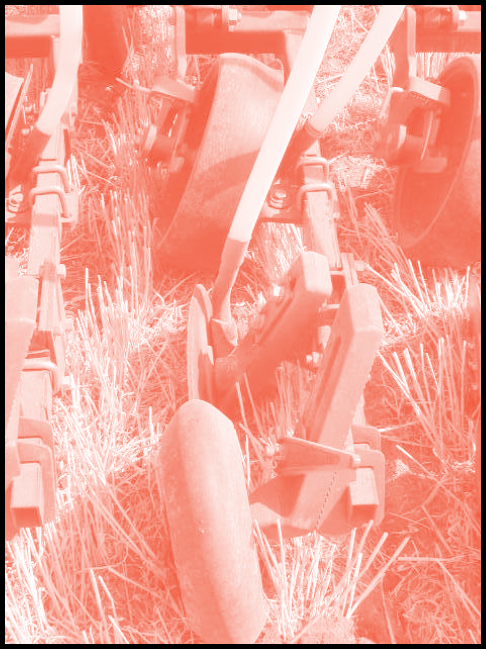
Foliar application involves spraying liquid fertilizer directly on leaf surfaces. Due to the potential for leaf burn and the inability to supply sufficiently large amounts of required nutrients, macronutrients are generally not foliar- applied. Conversely, micronutrients are sometimes foliar-applied because most are quite immobile in the soil, required in small amounts by crops, and produce positive growth responses (NM 2 and 7). Fertigation, the application of fertilizer through an irrigation system, is an attractive alternative to traditional fertilization methods for some nutrients (e.g., N and S) because fertilizer can be applied throughout the growing season, and application rates can be adjusted to match crop growth rates.
Fertilizer can be applied prior to seeding (preplant), at the time of seeding (starter), or after emergence (sidedress or topdress). N fertilizer may be applied any time from preplant to late season, whereas P fertilizer is generally applied preplant or as a starter fertilizer. Side-dressed fertilizer is typically applied between rows, and topdressed fertilizer is generally broadcast.
Fertilizer Placement Effects
Root Development
A goal of fertilizer placement is to maximize root-nutrient contact, especially at the early stages of crop/root development, without causing emergence or establishment problems. Placing fertilizer in the region that will have the highest density of fine roots, or in a location that the fertilizer will move to this region, is needed to optimize yield. So how do roots develop? The primary root develops first, followed by the first ‘seminal pair’ (Figure 3, next page). Less soluble fertilizers, such as P, placed below the seed will be accessed earlier in the growing season than fertilizers placed to the side of the seed as shown. Next, seminal pairs and crown roots (lateral roots above the seed) develop and are capable of accessing fertilizer placed to the side of the seed. Mature root systems generally grow much deeper than the depth of applied fertilizer, though final depth is dependent on crop and soil moisture (Figure 4). Deep roots can access mobile nutrients, such as nitrate, that are in fertilizer placed on or near the surface if moisture is sufficient, yet will have difficulty in accessing immobile fertilizer nutrients, such as P, that are placed on the surface.
Figure 2. Spoke applicator.

Figure 3. Root development at the 1-leaf stage of small grains and corn. Fertilizing to the side of the seed (a) does not allow the first seminal pair of roots to access the fertilizer as readily as fertilizing below the seed (b).

Figure 4. Mature root systems for alfalfa and winter wheat for dryland (a) and irrigated (b) systems. Grid lines are 1 foot apart (From Havlin et al., 1999).

Yield and Quality
Nitrogen
Large differences in yield and quality are generally not expected to be influenced by varying N fertilizer placement methods because nitrate is mobile in soils. However, semi-arid conditions in most of Montana and Wyoming increase the likelihood that placement may affect yield because nutrient mobility decreases with lower soil water content. A summary of research results from N placement studies follows.
A 1993 Montana study found spring wheat yields to be approximately 6% higher when urea was banded 1 in. below the seed and between rows compared to broadcast, although this difference was not statistically significant (Jacobsen et al., 1993). Another study in Montana found that barley recrop yields were approximately 4 bu/ac higher when 30 lb N/ac was applied with the seed, rather than broadcast, although this difference also was not significant (Jackson and Dubbs, 1987). In no-till continuous winter wheat, spring wheat, and spring barley, subsurface urea application (2 x 2) significantly increased grain yield compared to broadcast when the initial soil nitrate-N was less than 50 lb N/ac, but significantly decreased grain yield when soil nitrate-N was greater than 60 lb N/ac (Figure 5). The authors hypothesized that dry surface soil did not mobilize surface broadcast N soon enough to make up for low soil N, resulting in the yield response from banded urea in low nitrate-N soil. Therefore, N banding may only be useful in low soil N systems, such as in many continuous-crop cereal-grain systems, yet not in most fallow or cereal-legume systems (Kushnak et al., 1992).
Another study found that subsurface-banded and broadcast fall applications of urea did not produce significantly different winter wheat yields, but subsurface banding did increase grain protein by 1% compared to broadcast (Campbell et al., 1990). There were no differences in yield or protein between 2.5 and 5.0 in. banding depths. Surface banded ammonium nitrate increased hard red winter wheat yields by an average of 14% over three years compared to broadcast applications, although the difference was not significant (Rao and Dao, 1992). Conversely, seed- placed ammonium nitrate and urea decreased winter wheat grain yield and protein compared to early-spring broadcast in Saskatchewan, and was attributed to decreased winter hardiness (Fowler and Brydon, 1989; Fowler and Brydon, 1991).
An economic assessment of N placement effects on sugarbeet production at the University of Wyoming Research and Extension Center found that revenues (above fertilization and hauling costs) based on optimum N rates were higher for point injection than for either broadcast or knife N applications (Van Tassell et al., 1996). Specifically, revenues for point injection, broadcasting, and knife N applications were $966, $899, and $872/ ac, respectively. Point injection required 33 lb N/ac less fertilizer than broadcasting to maximize revenues. Crested wheatgrass yield was found to be 20-50% greater in North Dakota when N fertilizer was subsurface placed at a 4 in. depth than when it was broadcast, yet the effect was found to be due to the cultivating effect of the drill, rather than to fertilizer placement (Smika et al., 1963).
Figure 5. Effect of subsurface banding of urea (2 in. to the side and 2 in. below the seed) on grain yield of spring wheat, winter wheat, and spring barley as a function of soil nitrate-N concentration compared to broadcast urea. There was no yield change on one field with an initial soil nitrate-N of 31 lb/ac and another with 38 lb/ac. (Modified from Kushnak et al., 1992).
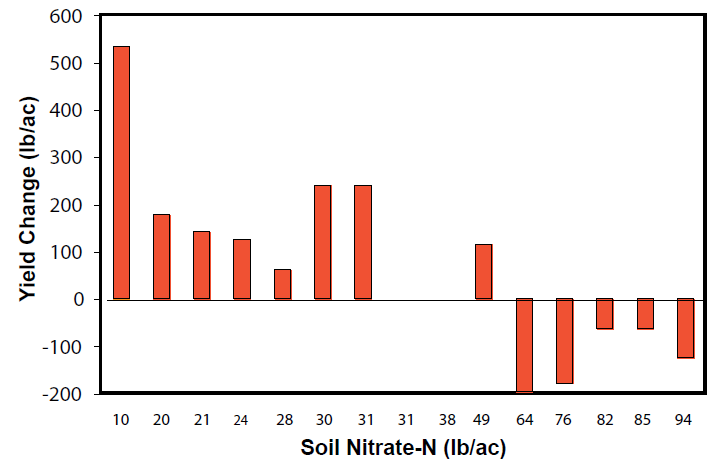
In summary, yield, quality, and revenue responses to different N placement methods are generally not very large or consistent. However, subsurface application of N may prove useful when soil nitrate-N levels are low (less than 50 lb/ac), and the surface soil is dry, and expected to stay dry.
Phosphorus
Unlike N, P is relatively immobile in the soil. Consequently, P placement is expected to cause larger effects on P availability and crop yield. For example, knifed and banded preplant P (40 lb P2O5/ ac) with 75 lb N/ac (as UAN) in dryland winter wheat produced about twice as much grain (29 vs. 14 bu/ac) than when the same fertilizer was broadcast (Leikam et al., 1983). This advantage was partially attributed to a lack of active roots near the surface of dry soils, which resulted in positional unavailability of broadcast P applications. The authors also found that dual knife N-P application increased yield and leaf P concentration significantly more than separate knifed N and P applications, suggesting a ‘synergistic’ effect of banding N and P together.
Figure 6. The effect of P fertilizer placement depth on winter wheat grain yield (Modified from McConnell et al., 1986). Data are averages from five fields in Year 1 and four different fields in Year 2.
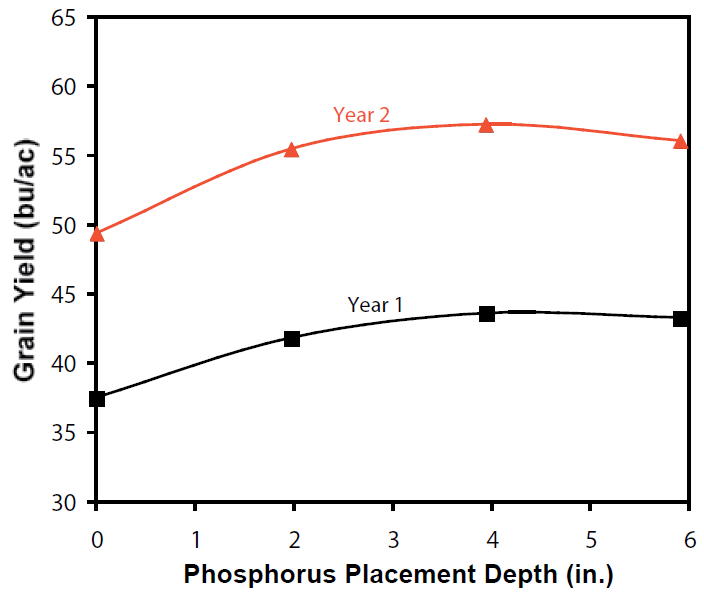
No significant grain yield differences were found between seed-placed P and deep banding in winter wheat, yet there was a significant yield increase for seed- placed P in canola (Nuttall and Button, 1990). A two-year, nine-field study on winter wheat compared four depths of banded P (as ammonium polyphosphate) placed 6 in. to the side of the seed row, on soils with low-medium STP levels (McConnell et al., 1986). The study found that P banded at 2, 4, and 6 in. produced significantly more grain yield than P banded at the original soil surface elevation (prior to creating a furrow), and P banded at 4 in. resulted in the highest average grain yield (Figure 6). Lastly, on a soil with a low STP level (6 ppm), banding 12 lb P2O5/ac with the seed or broadcasting 60 lb P2O5/ac both increased sugarbeet root yield and recoverable sucrose by similar amounts (50-60%), demonstrating a strong economic advantage of banding P (Sims and Smith, 2002).
So why does banding P increase P availability and crop yield? The conventional wisdom was that broadcast P results in much more fertilizer-soil contact, which precipitates or sorbs P, decreasing its availability. Instead, a study with ‘radiolabelled’ P found that P banding is more effective than broadcast P because it increases the chance that active roots will contact P, rather than due to decreased fertilizer-soil contact (Sleight et al., 1984). The results further suggest that P fertilizer might better be distributed within the root zone, rather than tightly banded.
In Montana, research has shown that applying P with the seed can increase both spring wheat and winter wheat yields compared to deep banding, even in soils testing high in P (Jackson et al., 1991a; Jackson et al., 1997). This is likely because fertilization near the seed partly overcomes slow P diffusion at seeding time. The only located research that found an exception to the general rule that placing P with the seed or banding P increases yield was on irrigated soybean, where a 2 x 2 band resulted in approximately 12% less yield than broadcasting and incorporating P at four different application rates (Randall and Hoeft, 1988). This may partly be due to the sensitivity of soybean to seed-placed fertilizer (Randall and Hoeft, 1988), or because the soybean roots were able to access more of the incorporated P than the banded P as discussed above.
In summary, research has shown that seed-placed or banded P generally increases crop yields, as compared to broadcast P, especially on low and medium P testing soils (Figure 7, next page). Additionally, deep banding N with P may further improve crop yields. On soils with high levels of available P, the advantage of banding is less because the crop obtains a higher proportion of P from the soil rather than from added fertilizer (see Q&A #1). However, when spring seeding in the Northern Great Plains, there may still be advantages of placing P with or near the seed due to poor uptake in cool soils, even in high STP soils (Alessi and Power, 1980; Jackson et al., 1991a; Jackson et al., 1997).
Figure 7. The advantages of P banding are greatest when STP levels are very low (VL) to low (L).

Q&A #1
How do I adjust P guidelines that are based on soil test phosphorus levels for banding P (like in Fertilizer Guidelines of Montana Crops, EB 161) if I only have equipment for broadcasting P?
The optimum adjustment will depend on a variety of factors, including crop and soil moisture. One approach is to multiply the P guidelines by 3 for low soil test P levels (<8 ppm) and by 2 for medium soil test P levels (8-12 ppm). There is likely little benefit in substantially adjusting the guidelines for high soil test P levels.
Potassium
The mobility of K is intermediate between N and P; therefore, effects of K placement are expected to be more than with N and less than with P. Starter K, either broadcast, banded, or placed with the seed, has been shown to increase yields by an average of 1.9 to 3.2 bu/ac for spring wheat, winter wheat, and spring barley in Montana (Jackson et al., 1991b). Still, relatively little research has been conducted comparing yield responses from various K placement techniques in this region. A three-year, 15-site study on K placement effects on no-till corn found that grain yield was significantly higher when K was deep-banded (6-8 in. deep, 30 in. spacing) than when it was seed-applied (2 x 2) or broadcast (Figure 8). The differences were not very large, likely because none of the soils in this study were low or very low in soil test K. Another study on no-till corn with a high soil test K (225 ppm) found that starter K either as a surface band above the furrow or with N fertilizer near the seed resulted in a 6% decrease in shoot dry weight, though no explanation was given for this difference (Riedell et al., 2000). In summary, the generally high soil test K values in much of Montana and Wyoming decreases the likelihood that K placement will have a large positive effect on crop yield in this region.
Figure 8. The effect of K placement on grain yield of no-till corn (Modified from Bordolli and Mallarino, 1998). Yield in t/ac was converted to bu/ac by assuming 56 lb/bu.
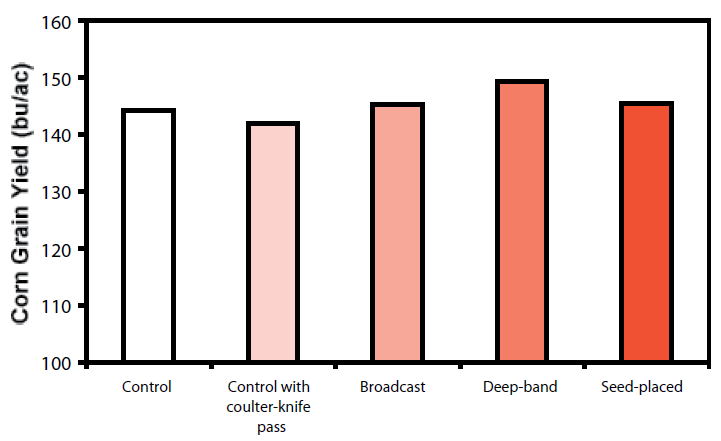
Sulfur and Micronutrients
Sulfate, the S form utilized by plants, is only slightly less mobile than nitrate. Therefore, large placement effects on yield are not expected when S is applied as a soluble fertilizer (e.g., ammonium sulfate, ammonium thiosulfate, potassium- magnesium sulfate). However, less soluble S fertilizer sources, such as gypsum and elemental S, make placement and timing more important. For example, because elemental S requires oxygen to make it available, it might be expected to be more available when placed on the surface than subsurface banded (NM 6). However, in a study in Northern Saskatchewan on canola and wheat, grain yields from broadcasting or shallow banding elemental S were not significantly different (Nuttall et al., 1993).
Metal micronutrients are less mobile than P; therefore, placement of metal micronutrient fertilizers in a subsurface band near the seed or on the leaves (foliar application) is expected to produce larger metal uptake and yield responses than broadcast applications. For example, foliar applications of ZnSO4 increased Zn leaf tissue concentrations of four crops by 30-100% compared to broadcast soil-applied Zn, even when the foliar applications were applied at 5% of the soil rate (Havlin et al., 1999).
Boron is more mobile than the metal micronutrients, yet foliar applications are also effective, especially for vegetables, and require less than 20% the rate of broadcast boron applications to obtain similar responses (Havlin et al., 1999). Boron should not be placed with the seed due to its toxicity. Chloride is the most mobile nutrient, so placement method is likely not important except due to its effect on germination (discussed below).
Germination and Emergence
Placing fertilizer with the seed raises the possibility of poor germination and delayed emergence due to high salts. The effect is highly dependent on the specific fertilizer’s ‘salt index’ (NM 10). For example, KCl (0-0-60) and NH4NO3 (34-0-0) have the two highest salt indices, and therefore have a high potential to negatively impact seed germination if placed with the seed. Conversely, MAP (11-52-0) and DAP (18-46-0) have low salt indices and cause only minimal germination problems (Deibert et al., 1985).
Urea (46-0-0) causes larger emergence problems than NH4NO3 (Deibert et al., 1985), as a result of free ammonia formation. Specifically, 80 lb N/ac caused a 73% barley stand reduction when applied as urea, but only a 13% stand reduction when applied as NH4NO3 (Figure 9).
These reductions would be expected to be substantially less with modern air drills.
Figure 9. The effect of seed-placed fertilizer source and rate on barley stand reduction (Modified from Brage et al., 1960).

Spreading fertilizer and seed in a widem band can minimize germination problems due to less direct contact between fertilizer and seed. For example, spreading 40 lb N/ ac as urea and seed in a 6 in. band resulted in a spring wheat stand reduction of 25%, compared to an 80% stand reduction when urea and seed were applied in a 1 in. band (Deibert et al, 1985). Coated urea produced only minimal (<5%) stand reductions in this study, likely because coatings reduce the speed that urea converts to ammonia.
The effect of fertilizer on germination and emergence is also crop and row-spacing dependent. In Fertilizer Guidelines for Montana Crops, crop- specific recommendations are given for the maximum amount of fertilizer to place with the seed to avoid germination problems (Jacobsen et al., 2005).
Fertilizer Use Efficiency and Water Quality
Maximizing the percentage of applied fertilizer that is taken up by the crop (‘use efficiency’) is important to minimize both fertilizer costs and potential nutrient loss from a field. Fertilizer placement has been found to affect both N and P use efficiencies (NUE and PUE), even in cases where yield was not increased. NUE was found to increase in winter wheat when NH4NO3 was surface banded compared to broadcast (Rao and Dao, 1992). This was attributed to greater N immobilization from the broadcast application because the fertilizer came into contact with more soil microbes. In another winter wheat study, grain NUE was significantly higher in plots where urea was fall-banded at 4 in. depth than when N was fall-broadcast (Campbell et al., 1990). This effect was largely negated when an additional 45 lb N/ac was broadcast in the spring, although this additional application significantly decreased grain NUE (Figure 10). Banding the urea at 4 in. depth produced higher grain NUE than when banding at 2 in. depth. Yield was not significantly different among placement methods in this study, but grain protein was significantly higher when the urea was subsurface banded. Others have found little correlation between placement method and NUE (Petersen, 2001).
Figure 10. The effect of fall urea placement on grain nitrogen use efficiency of winter wheat with and without a spring urea application (Modified from Campbell et al., 1990).
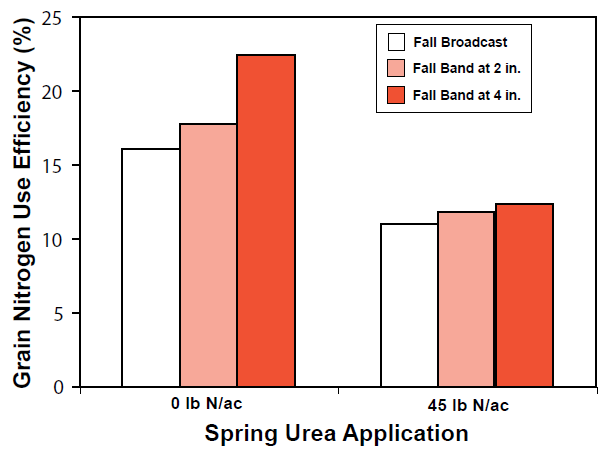
Phosphorus use efficiency (PUE) in winter wheat was found to be significantly higher when P was banded at 4 in. depth than when it was banded at either the original soil surface or 2 in. (McConnell et al., 1986). Banded and seed-placed P applications have also been found to significantly increase PUE over broadcast P in winter wheat (Sander et al., 1991). These results are not surprising given that banding P generally increases yield as pointed out earlier.
Placement can potentially affect water quality by altering nutrient leaching and runoff losses. For example, runoff losses of ammonium and phosphate were significantly less when MAP plus NH4NO3 fertilizer were injected at a 2 in. depth rather than broadcast (Baker and Laflen, 1982).
Weeds
Weed densities can be less with banded nutrient applications compared to broadcast applications because fewer nutrients are available to the weeds, and more are available to the crop. A Northern Great Plains study found that weed densities and biomass of wild oat and green foxtail in spring wheat fields decreased 20-40% when fertilizer was side-banded at 2.4 – 3.6 in. depth rather than broadcast (Kirkland and Beckie, 1998). The authors noted that banding fertilizer was likely not sufficient for adequate weed control by itself, but combined with other practices (such as increased seeding density and diverse rotations), banding could decrease herbicide inputs without loss of crop yield.
Figure 11. Nitrogen accumulation in leaves, stem, head, and grain for HRS wheat (Modified from Jacobsen et al., 1992). Growing Degree Units = ((daily max temp. – daily min temp)/2)-50 where temperatures are in deg. F and GDU are summed from day of planting.
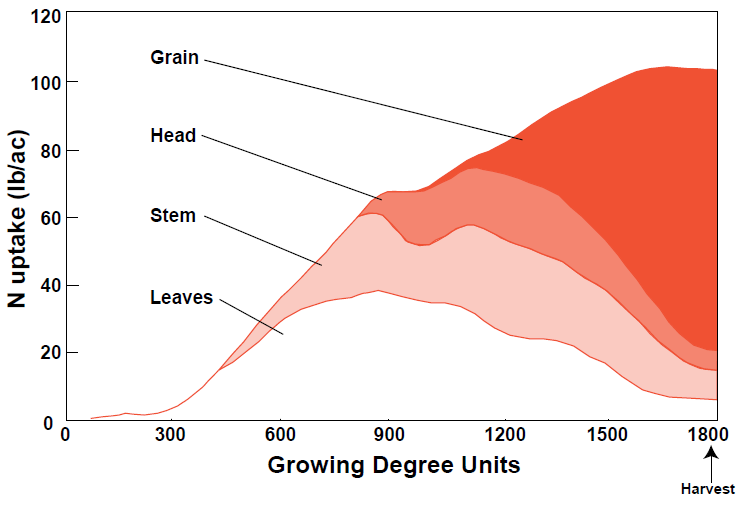
Fertilizer Application Timing Effects
Timing fertilization with peak nutrient uptake demand is essential for optimizing both yield and quality. In general, nutrient uptake rates are highest from early to mid- growing season, which is why fertilization near the time of seeding is generally very effective (NM 2). Spring N applications have been found to be 5-10% more efficient than fall applications on fine to medium textured soils, and 10-30% more efficient on coarse soils, due to losses such as leaching (Havlin et al., 1999), although these differences are expected to be less in this region’s semi-arid climate. With fall- planted grains, fall N fertilization followed by spring topdressing is likely the best combination of fertilization practices to optimize yield.
P should be applied immediately before or at planting due to its immobility in soil (NM 4). Topdressing of P is not expected to affect crop yield because the P would likely become bound near the soil surface and not migrate to the actively growing root system. As pointed out earlier, starter K has been found to increase spring wheat yield due to poor diffusion in this region’s cool soils. Effectiveness of S fertilizer can be substantially affected by timing, especially for elemental S, which needs to be oxidized before becoming available. For example, elemental S broadcast before planting resulted in significantly more wheat grain yield than when broadcast after planting, whereas the timing of AS application resulted in essentially identical yields (Nuttall et al., 1993).
Grain yield and quality may be affected by mid- and late-season applications of N because much of the plant N is translocated to the grain for protein synthesis (Figure 11). For example, 40 lb N/ac applied at heading increased irrigated spring wheat grain protein by 0.5 to 2.0% at six sites in Montana (Westcott et al., 1998). Due to premiums paid for higher grain protein, net crop values for this study increased by an average of $25/ac over two years at 4-6 sites in Montana, corresponding to a state- wide potential value of $2.5 - $4.5 million dollars.
Winter wheat yield and protein increased by up to 15 bu/ac and 1.8%, respectively, when 30 lb N/ac was applied at tillering, although there was substantial variability between sites (Lorbeer et al., 2000). Smaller increases were observed on plots applied with more early spring N, and there were only minor differences in yield and protein when the same total amount of N was applied in either the split application or only in early spring. To determine if late-season N will be beneficial, flag leaf N concentrations or SPAD (chlorophyll meter) readings can be used as indicators of N nutrition (Q&A #2). A study in Montana on dryland durum showed that 20 lb/ac of top-dressed N applied when plant stems were beginning to elongate (Feekes stage 4-5) increased yield by an average of 1.3 bu/ac for two cultivars compared to 20 lb/ac preplant N, and increased protein by 0.2%, although neither difference was significant (Eckhoff, 2003).
Summary
Fertilizer placement and timing can have substantial effects on both crop yield and quality. Placement techniques include broadcast, banded (surface or subsurface), seed-applied, and foliar applications. The likelihood of a placement response for a particular nutrient is related to both the mobility of that nutrient and on water availability. For example, yield responses from placement of N, which is highly mobile, are less than for P and metal micronutrients, which are relatively immobile. Some research showed relatively few differences in yield response for different N application placement methods, although urea placed 2 in. to the side and 2 in. below the seed increased winter wheat grain yield compared to broadcast applications on dry soils with less than 50 lb N/ac soil nitrate. In general, applying P with the seed, or up to two inches below the seed, is expected to produce the largest, most consistent growth responses to P fertilizer especially for low P soils.
Placement of nutrients near the seed can also increase nutrient use efficiency, a benefit to both producers’ net income and possibly water quality. In addition, banded N has been found to result in significantly less weed pressure. N and K placement with or very near the seed can negatively affect germination and emergence; therefore, it is recommended that less than 30 lb N+ K2O/ac be applied directly with the seed. The maximum amount of seed-placed nutrients varies with crop, moisture, and fertilization/seeding equipment.
Timing of fertilizer application can also affect both yield and quality. Applying near the time of seeding generally will produce high levels of nutrients in time for peak growth demand that occurs from early-mid growing season. Late-season N applications after flowering generally increase wheat grain protein, and premiums paid to the producer, although these increases are smaller when adequate preplant N is applied. In summary, appropriate placement and timing methods can aid producers in efficiently using fertilizers and maximizing economic returns, while possibly reducing weeds and potential nutrient loss from fields.
Q&A #2
How do I know if late- season N applications will produce a protein response?
Flag leaf N concentrations and SPAD readings can both indicate the likelihood of a protein response for N applied at heading. For example, fertilizing when flag leaf N concentrations were below 4.2% consistently produced protein responses in irrigated spring wheat in Montana (Westcott et al., 1997). Similarly, when SPAD readings are expressed as a fraction of an optimum (high N) SPAD reading for a particular site, fertilizing when the value was below 0.93 also produced protein responses. As with any research, these ‘critical values’ will likely need to be adjusted for a particular field. For more details, see Fertilizer Fact Sheets 12 and 23 for spring wheat and winter wheat, respectively.
References
Alessi, J. and J.F. Power. 1980. Effects of banded and residual fertilizer phosphorus on dryland spring wheat yield in the Northern Plains. Soi Sci. Soc. Am. J. 44:792-796.
Baker, J.L. and J.M. Laflen. 1982. Effects of corn residue and fertilizer management on soluble nutrient runoff loss. Trans. ASAE. 25:344-348.
Bordoli, J.M. and A.P. Mallarino. 1998. Deep and shallow banding of phosphorus and potassium as alternatives to broadcast fertilization for no-till corn. Agron. J. 90:27-33.
Brage, B.L., W.R. Zich, and L.O. Fine. 1960. The germination of small grain and corn as influenced by urea and other nitrogenous fertilizers. Soil Sci. Soc. Am. Proceedings. 24: 294-296.
Campbell, C.A., J.G. McLeod, F. Selles, F.B. Dyck, C. Vera, and D.B. Fowler. 1990. Effect of rate, timing and placement of N fertilizer on stubbled-in winter wheat grown on a brown Chernozem. Can. J. Plant Sci. 70:151-162.
Deibert, E.J., D.A. Lizotte, and B.R. Bock. 1985. Wheat seed germination as influenced by fertilizer rate, fertilizer source, and spreader type with one-pass pneumatic seeding-fertilizing. N. Dak. Farm Res. 42(6):14-20.
Eckhoff, J.L.A. 2003. Response of durum and spring wheat to nitrogen and sulfur. Fertilizer Fact #30. Montana State University Extension and Agricultural Experiment Station. Bozeman, Montana.
Fowler, D.B. and J. Brydon. 1989. No-till winter wheat production on the Canadian prairies: Placement of urea and ammonium nitrate fertilizers. Agron. J. 81:518-524.
Fowler, D.B. and J. Brydon. 1991. Response of no-till winter wheat to seed-placed ammonium nitrate fertilizer. Can. J. Soil Sci. 71:55-66.
Havlin, J.L., J.D. Beaton, S.L. Tisdale, and W.L. Nelson. 1999. Soil Fertility and Fertilizers, 6th Edition. Upper Saddle River, N.J. Prentice-Hall, Inc. 499 p.
Jackson, G.D. and A.L. Dubbs. 1987. Spring wheat and barley response to urea fertilizer placement and nitrogen rate. Montana Ag. Res. 4:10-13.
Jackson, G.D., G.D. Kushnak, G.R. Carlson, D.M. Wichman, and J.S Jacobsen. 1991a. Correlation of the Olsen phosphorus soil test: Winter wheat response. Comm. Soil Sci. Plant Anal. 22:907-918.
Jackson, G.D., G.D. Kushnak, A.N. Benson, E.O. Skogley, and R.E. Lund. 1991b. Potassium response in to-till small grain production. J. Fert. Issues. 8: 89-92.
Jackson, G.D., G.D. Kushnak, G.R. Carlson, and D.M. Wichman. 1997. Correlation of the Olsen phosphorus test: Spring wheat response. Comm. Soil Sci. Plant Anal. 28:813-822.
Jacobsen, J.S., R.O. Miller, and E.O. Skogley. 1992. Nitrogen, phosphorus, and potassium accumulation by hard red spring wheat. Montana Ag. Res. 8:23-26.
Jacobsen, J.S., D.L. Tanaka, and J.W. Bauder. 1993. Spring wheat response to fertilizer placement and nitrogen rate with limited moisture. Comm. Soil Sci. Plant Anal. 24:187-195.
Jacobsen, J., G. Jackson, and C. Jones. 2005. Fertilizer Guidelines for Montana Crops. Montana State University Extension: Bozeman, MT. EB 161.
Kirkland, K.J. and H.J. Beckie. 1998. Contribution of nitrogen fertilizer placement to weed management in spring wheat (triticum aestivum). Weed Tech. 12:507-514.
Kushnak, G.D., G.D. Jackson, R.K. Berg, and G.R. Carlson. 1992. Effect of nitrogen and nitrogen placement on no-till small grains: Plant and yield relationships. Commun. Soil Sci. Plant Anal. 23:2437-2449.
Leikam, D.F., L.S. Murphy, D.E. Kissel, D.A. Whitney, and H.C. Moser. 1983. Effects on nitrogen and phosphorus application method and nitrogen source on winter wheat grain yield and leaf tissue phosphorus. Soil Sci. Soc. Am. J. 47:530-535.
Lorbeer, S., J. Jacobsen, P. Bruckner, D. Wichman, and J. Berg. 2000. Capturing the genetic protein potential in winter wheat. Fertilizer Fact #23. Montana State University Extension and Agricultural Experiment Station. Bozeman, Montana.
McConnell, S.G., D.H. Sander, and G.A. Peterson. 1986. Effect of fertilizer phosphorus placement depth on winter wheat yield. Soil Sci. Soc. Am. J. 50:148-153.
Nuttall, W.F. and R.G. Button. 1990. The effect of deep banding N and P fertilizer on the yield of canola (brassica napus L.) and spring wheat (triticum aestivum L.). Can J. Soil Sci. 70:629-639.
Nuttall, W.F., C.C. Boswell, A.G. Sinclair, A.P. Moulin, L.J. Townley-Smith, and G.L. Galloway. 1993. The effect of time of application and placement of sulphur fertilizer sources on yield of wheat, canola, and barley. Comm. Soil Sci. Plant Anal. 24:2193-2202.
Petersen, J. 2001. Recovery of 15N-ammonium-15N-nitrate in spring wheat as affected by placement geometry of the fertilizer band. Nut. Cycling in Agroecosystems 61:215-221.
Randall, G.W. and R.G. Hoeft. 1988. Placement methods for improved efficiency of P and K fertilizers: A review. J. Prod. Agric. 1:70-78.
Rao, S.C. and T.H. Dao. 1992. Fertilizer placement and tillage effects of nitrogen assimilation by wheat. Agron. J. 84:1028- 1032.
Riedell, W.E., D.L. Beck, and T.E. Schumacher. 2000. Corn response to fertilizer placement treatments in an irrigated no- till system. Agron. J. 92:316- 320.
Sander, D.H., E.J. Penas, and D.T. Walters. 1991. Winter wheat phosphorus fertilization as influenced by glacial till and loess soils. Soil Sci. Soc. Am. J. 55:1474-1479.
Sleight, D.M., D.H. Sander, and G.A. Peterson. 1984. Effect of fertilizer phosphorus placement on the availability of phosphorus. Soil Sci. Soc. Am. J. 48:336-340.
Sims, A.L. and L.J. Smith. 2002. Use of Starter Fertilizer to Reduce Broadcast Applications of Phosphorus. 2002 Sugarbeet Research and Extension Reports. 33:94-99.
Smika, D.E., H.J. Haas, and G.A. Rogler. 1963. Native grass and crested wheatgrass production as influenced by fertilizer placement and weed control. J. Range Manage. 16:5-8.
Van Tassel, L.W., B. Yang, and A.D. Blaylock. 1996. An economic analysis of alternative nitrogen fertilization methods for sugarbeets. J. Prod. Agric. 9: 390-394.
Westcott, M. J., Eckhoff, R. Engel, J. Jacobsen, G. Jackson, and B. Stougaard. 1997. Flag leaf diagnosis of grain protein response to late-season N application in irrigated spring wheat. Fertilizer Fact #12. Montana State University Extension and Agricultural Experiment Station. Bozeman, Montana.
Westcott, M., G. Carlson, J. Jacobsen, J. Eckhoff, G. Jackson, and B. Stougaard. 1998. Economic value of late-season N applications to irrigated spring wheat. Fertilizer Fact #20. Montana State University Extension and Agricultural Experiment Station. Bozeman, Montana.
Appendix
Books
Western Fertilizer Handbook, 9th Edition. California Plant Health Association. 2002. Danville, IL. Interstate Publishers. 351 p. (www.amazon.com) $50.
Soil Fertility and Fertilizers, 6th Edition. J.L. Havlin et al. 1999. Upper Saddle River, NJ. Prentice Hall. 499 p. Approximately $100.
Extension Materials
Fertilizer Guidelines for Montana Crops. EB 161. Free.
Nutrient Management Modules 1-15. All are online in PDF format in the category of ag and natural resources, at http://www.msuextension.org/publications.asp
Extension Materials can be obtained from:
Please enclose $1 for shipping of free publications.
See also Web Resources for online ordering information.
Personel
Engel, Rick. Associate Professor. Montana State University, Bozeman. (406) 994-5295. engel@montana.edu
Jackson, Grant. Professor. Western Triangle Agricultural Research Center, Conrad. (406) 278-7707. gjackson@montana.edu
Jones, Clain. Extension Soil Fertility Specialist. Montana State University, Bozeman. (406) 994-6076. clainj@montana.edu
Westcott, Mal. Professor. Western Agricultural Research Center, Corvalis. (406) 961-3025. westcott@montana.edu
Web Resources
http://www1.agric.gov.ab.ca/$department/deptdocs.nsf/all/agdex621 Alberta’s Agriculture, Food, and Rural Development site on fertilizer application and placement.
http://www.canola-council.org/chapter9.aspx#ch9_sec7 Canola-council tips on N placement and timing.
http://www.msuextension.org/publications.asp Montana State University Extension Publications ordering information for printed materials.
http://landresources.montana.edu/FertilizerFacts/ Fertilizer Facts summarizing fertilizer findings and recommendations based on field research conducted by Montana State University personnel.
http://msucares.com/pubs/techbulletins/tb211.htm Report on effects of placement on water quality.
Acknowledgements
We would like to extend our utmost appreciation to the following volunteer reviewers who provided their time and insight in making this a better document:
Steve Hutton, former Pondera County Extension Agent, Conrad, Montana
Grant Jackson, Western Triangle Agricultural Research Center, Conrad, Montana
Dale Leikam, formerly with Department of Agronomy, Kansas State University, Manhattan, Kansas. Currently, President, Fluid Fertilizer Foundation.
Kerry Rasmussen, Sidney Sugars, Sidney, Montana

